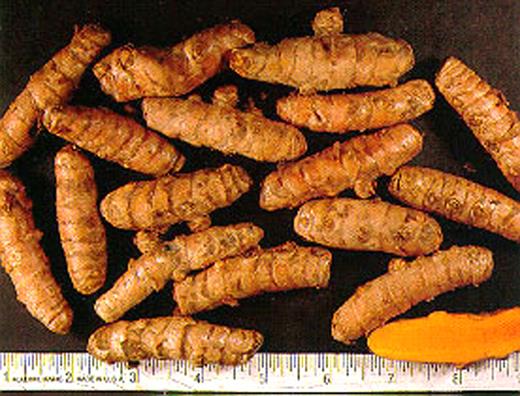At least some of the beneficial effects attributed to the complementary medicine agent curcumin may result from its iron chelating properties.
Turmeric, a yellow powder derived from the root of the flowering plant Curcuma longa, is both a dye and an aromatic spice frequently used in Asian and Indian cooking.1 It also has a long history of use in Eastern traditional medicine for a wide variety of disorders. The active agent in turmeric is the polyphenol curcumin, which has been shown to have antineoplastic activity in vitro and chemopreventive effects in animal models of induced cancer. When combined with its favorable toxicity profile, these features have helped curcumin make the transition “from the kitchen to the clinic.”2
Curcumin has been reported to have a wide variety of cellular and molecular effects, including inhibition of NFκB, COX2 activation, Akt inhibition, and a variety of redox effects, both pro-oxidant and antioxidant. In this issue of Blood, Jiao and colleagues demonstrate that curcumin can act as an iron chelator in vivo.
In a previous report, the same group had noted in vitro reduction of cellular ferritin by curcumin and suggested that curcumin had moderate iron chelating activity.3 In this present study, the authors first establish baseline hematologic and iron parameters for micefed diets that ranged from minimal iron(5 mg/kg added iron) to excessive iron (1000 mg/kg added iron). The addition of curcumin induced a state of overt iron deficiency anemia in mice on the marginal iron diet and produced evidence of iron mobilization in mice at all dietary iron levels, as indicated by declines in liver ferritin and increases in liver transferrin receptor-1 and iron regulatory protein activity. Curcumin decreased hepcidin expression. The biologic relevance of these changes was confirmed by demonstration of consequent increases in cellular ferroportin protein.
Although this study is not the first to propose iron chelation as an effect of curcumin,4 it is the first to thoroughly demonstrate iron chelation in vivo and to confirm this by demonstrating predicted changes in the iron regulatory system. The study has limitations: for valid technical reasons, the indicators of iron mobilization studied differed between mice on the high iron diet and the marginal iron diet, and wide variation of hepcidin expression in the low iron diet control mice precluded demonstration of a statistically significant effect of curcumin on hepcidin in vivo. The hepcidin/ferroportin results described above were therefore demonstrated using the HepG2 cell line. The important question of whether the variety of cellular effects reported for curcumin are consequences of its iron chelating activity or are independent of this activity was outside the scope of this report.
A search of the website www.clinicaltrials.gov in October 2008 showed 23 therapeutic or chemopreventive trials using curcumin in a wide variety of diseases. The 3 most frequently studied were colorectal cancer, pancreatic cancer, and Alzheimer disease. Other diseases under study included multiple myeloma, myelodysplastic syndrome, rheumatoid arthritis, and psoriasis. The report by Jiao et al leads to a number of important questions relevant to the clinical use of curcumin. Does the tolerability of large doses of curcumin offset its relatively modest chelating activity, making it a viable therapeutic option for clinical chelation? Does its chelating effect impose limitations on its use as adjunctive or chemopreventive therapy in patients with marginal iron stores? Marginal or absent iron stores are common in patients with colon cancer,5 the disease in which curcumin is most commonly studied at present. A similar concern would potentially apply to its use in women with limited iron stores due to menstrual or gestational blood loss. For patients with hypoferremia due to the anemia of chronic disease, would curcumin exacerbate anemia, or would its effects on hepcidin alter the effects of hepcidin on other aspects of erythropoiesis in a favorable direction?6 Like much good research, the current report answers some questions while giving rise to new ones.
The root of iron chelation? Reprinted with permission from the California Department of Food and Agriculture.
The root of iron chelation? Reprinted with permission from the California Department of Food and Agriculture.
Conflict-of-interest disclosure: The author declares no competing financial interests. ■


This feature is available to Subscribers Only
Sign In or Create an Account Close Modal